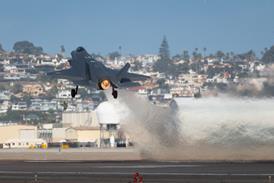Lockheed Martin expects to seal the deal for 90 F-35 Lightning IIs in low-rate initial production lot 10, chief executive Marillyn Hewson told investors during a 24 January fourth quarter 2016 earnings call.
Following a meeting at the White House with President Donald Trump on 23 January, Hewson said Lockheed is very close to a deal that would allow the company to close LRIP 10 in the near term.
“The meetings have been very productive,” Hewson says. “He asks very good questions and wants to make sure price goes down. It’s not about slashing our margins. I’ve had opportunity to share with him things the [Defense Department] can do and how they might buy the aircraft differently in the future to help drive the cost down.”
The company is also expected to negotiate lot 11 by the end of 2017, Lockheed chief financial officer Bruce Tanner adds. 2017 will mark a significant ramp up for the F-35 production line, with 66 aircraft expected to deliver by the end of the year compared to 46 delivered in 2016.
Hewson also touted that Lockheed will lower the unit price for lot 10, which should come in under $100 million and $85 million by LRIP 13 in 2019. But those prices haven’t come out of meetings with Trump. For several years, government and industry programme officials have set a goal to lower the unit price for the F-35A to $80-85 million before the programme enters full-rate production.
Same goes for Hewson’s announcement after meeting with Trump 13 January. Hewson told reporters in Trump Tower that Lockheed would add 1,800 jobs to its F-35 production plant in Fort Worth, Texas, a plan that had been in the works since 2015.
During the earnings call, Hewson added Lockheed is not under any pressure to take legal action on the LRIP 9 contract at this time. After more than a year of protracted negotiations, the Pentagon took unilateral action in November on LRIP 9, awarding Lockheed $6.1 billion for the delivery of 57 airframes and engines.
Lockheed expressed its disapproval of the Pentagon’s decision and noted it would weigh whether it should reject the LRIP 9 contract terms through an appeal with the Armed Services Board of Contracts Appeals. The company has 90 days from the point of the contract award to decide.
“We’re going to continue to look at our options on LRIP 9,” Hewson says.
Source: FlightGlobal.com























